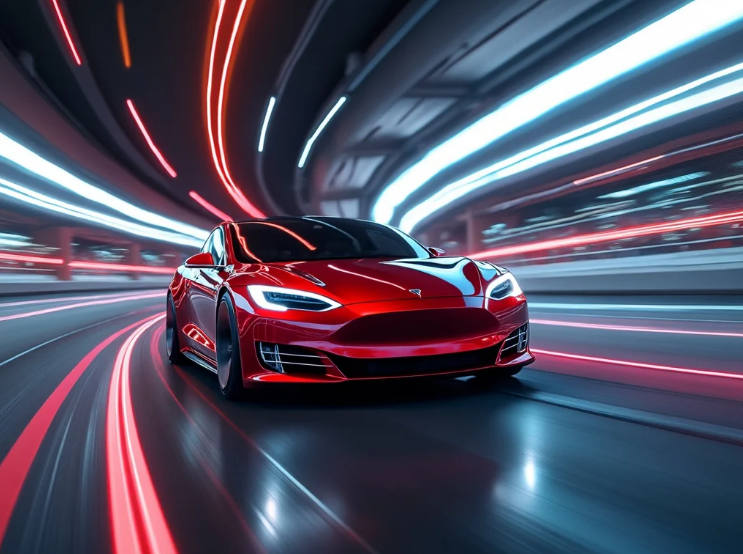Introduction to Tesla’s Robotaxi
The future of transportation is on the brink of a revolution, and Tesla is at the forefront. Imagine hailing a ride without needing a driver—just you and your smartphone. That’s the vision behind when will tesla release robotaxi. This groundbreaking innovation promises to change how we think about travel, making it more efficient, affordable, and environmentally friendly.
But when will Tesla release Robotaxi? The anticipation builds as enthusiasts and skeptics alike ponder its potential impact on the industry. With autonomous vehicles gaining traction, it’s crucial to explore what this technology means for our everyday lives—and for companies scrambling to keep up with Elon Musk’s ambitious plans. Strap in; we’re about to dive into the world of Robotaxis!
How it works and its potential impact on the industry
Tesla’s Robotaxi leverages cutting-edge artificial intelligence and advanced sensors to navigate urban environments autonomously. Utilizing a vast network of data from existing Tesla vehicles, it learns traffic patterns, road conditions, and passenger preferences in real-time.
This innovation could redefine transportation as we know it. With the ability to dispatch electric taxis on-demand, users might experience reduced costs compared to traditional ridesharing services. Imagine hopping into a self-driving car without the hassle of ownership or maintenance.
The broader industry stands to feel significant shifts too. Ride-sharing giants may need to adapt rapidly or risk falling behind. Additionally, municipalities will have to rethink regulations surrounding autonomous vehicles for safety and infrastructure adaptation.
As this technology matures, cities could become less congested with fewer personal vehicles on the road—paving the way for cleaner air and more efficient transit systems that serve everyone better than before.
Advantages and disadvantages of a fully autonomous taxi service
Fully autonomous taxi services offer numerous advantages. They can significantly reduce human error, resulting in safer roads. The potential for lower operating costs is enticing as well. Without drivers to pay, companies could pass savings onto customers.
However, there are notable disadvantages too. Job displacement remains a critical concern for many workers in the transportation industry. As technology progresses, resistance from unions and labor groups could escalate.
Additionally, safety regulations pose challenges that need addressing before widespread adoption. Public trust in self-driving vehicles is still shaky; incidents or accidents could deter users.
Moreover, ethical dilemmas arise regarding decision-making during unavoidable accidents—who decides what happens? Such complex issues complicate the path forward for fully autonomous taxis while showcasing their transformative potential.
Challenges and obstacles for Tesla in releasing Robotaxi
Tesla faces significant hurdles in launching its Robotaxi service. Regulatory approvals are among the most pressing challenges. Each region has different laws regarding autonomous vehicles, and navigating this complex landscape can slow down progress.
Another obstacle is safety concerns. Critics question whether fully autonomous cars can operate without human intervention reliably. Any incident could lead to public backlash and further regulatory scrutiny.
Moreover, Tesla must ensure robust technology development. The software needs continuous updates to handle real-world driving scenarios effectively. Bugs or failures in the system could jeopardize the entire rollout.
Competition is fierce. Other companies are racing to develop similar technologies, putting additional pressure on Tesla to deliver a superior product quickly while maintaining high standards of performance and safety.
Predictions for the official release date
As anticipation builds around Tesla’s Robotaxi, speculation surrounding its release date intensifies. Elon Musk has hinted at ambitious timelines in various public statements. Many industry experts believe that 2024 might be the year we see a significant rollout.
However, this timeline is contingent upon achieving regulatory approvals and addressing safety concerns. The complexity of autonomous driving technology adds another layer of uncertainty to any predictions.
Some analysts suggest that gradual deployment could start as early as late 2023 in select markets. This would allow for real-world testing while gathering valuable data for further refinements.
Others remain skeptical due to past delays with other Tesla projects. They argue that rushing could lead to setbacks or safety issues down the line.
Only time will tell how accurate these predictions prove to be as Tesla navigates both technological and regulatory landscapes.
Impact on other companies and their response to Tesla’s innovation
Tesla’s Robotaxi concept is shaking up the entire transportation industry. Traditional taxi services are feeling the pressure to innovate or risk becoming obsolete.
Established ride-hailing companies like Uber and Lyft are being forced to rethink their strategies. They might invest heavily in autonomous technology, seeking partnerships with tech firms to keep pace.
Automakers not previously associated with ride-sharing are also taking note. Companies like Ford and General Motors could pivot, focusing on developing their own autonomous fleets.
Startups specializing in self-driving technology see a surge of interest too. Venture capital may flow into these businesses as investors look for the next big opportunity.
The competitive landscape is evolving rapidly. Tesla’s bold moves inspire both innovation and fear among competitors, igniting a race towards autonomy that could redefine personal mobility forever.
Conclusion:
Tesla’s Robotaxi is poised to revolutionize the transportation industry. With its promise of a fully autonomous taxi service, it could change how we think about mobility. The technology behind this innovation is groundbreaking, leveraging advanced AI and self-driving capabilities.
However, there are both advantages and disadvantages to consider. On one hand, Robotaxis could reduce traffic congestion and emissions while providing convenient rides at lower costs. On the other hand, concerns over safety and regulatory hurdles remain significant challenges that Tesla must address before launching their service.
The timeline for when will Tesla release Robotaxi has been a topic of much speculation. While Elon Musk has hinted at ambitious goals in previous statements, various factors including technological readiness and regulatory approval can influence actual launch dates.
Moreover, the impact on competitors cannot be overlooked. Other companies are under pressure to innovate as they respond to Tesla’s advancements in autonomous vehicle technology. This creates a ripple effect in the industry that may lead to faster adoption of similar services across different platforms.
As we await more concrete information from Tesla regarding their when will tesla release robotaxi initiative, excitement continues to build around what this new era of transportation might hold for everyone involved—riders, cities, even traditional ride-hailing services may find themselves navigating uncharted waters soon enough.


